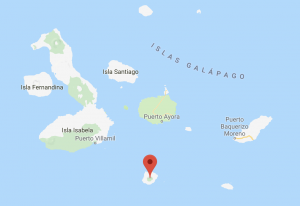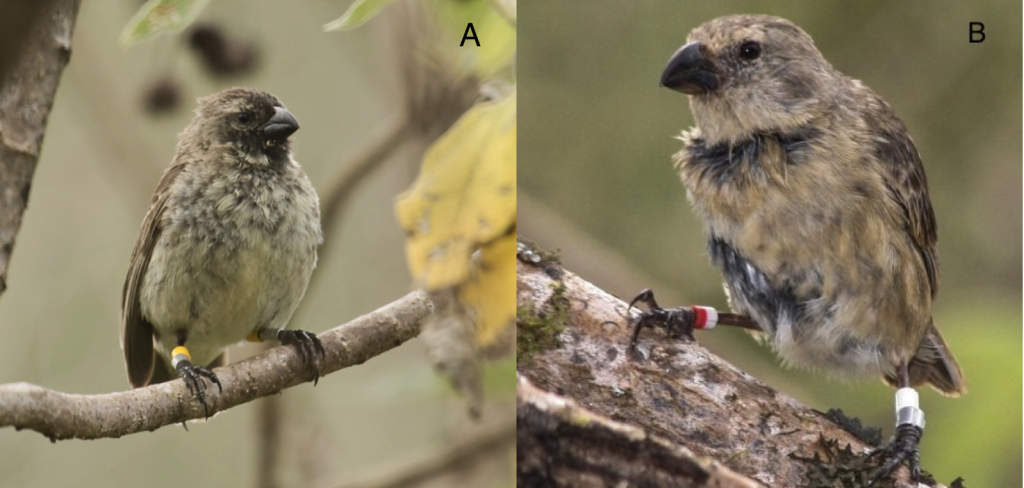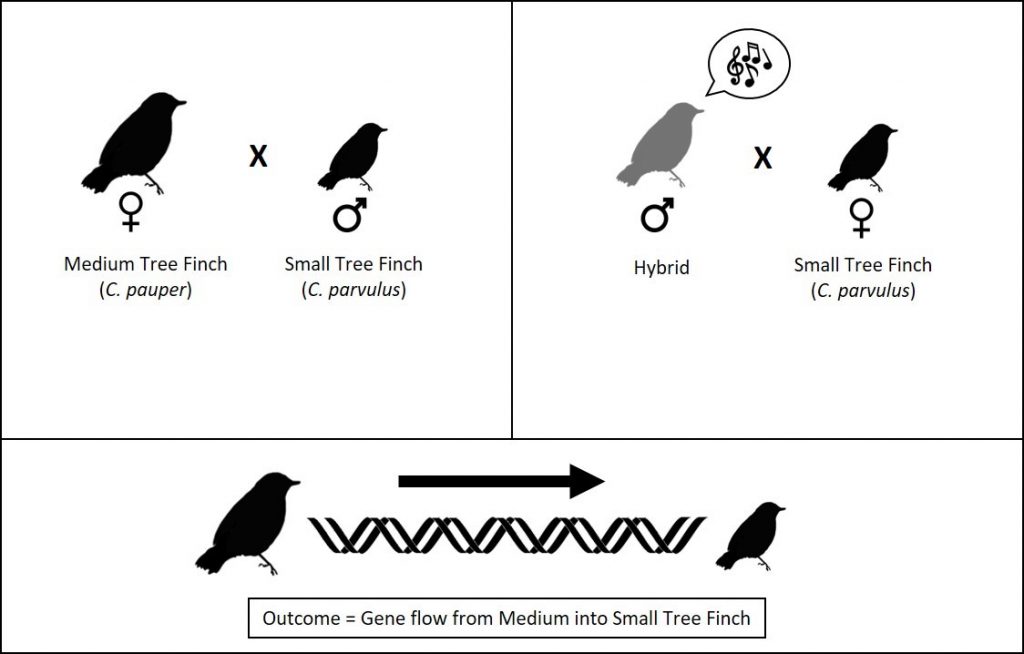Background: what’s happening, and where?

In 1998, one of Charles Darwin’s famous finches, the medium tree finch, was classified as threatened on the International Union for Conservation of Nature’s (ICUN) red list (BirdLife, 2018). The medium tree finch, otherwise known as Camahynchus pauper, was named for the size of its short, curved beak. It can be found living only on Floreana island, an island that is part of the Galapágos Islands archipelago (bottom center of fig. 1). Over the last couple hundred years, this finch has faced numerous threats to its survival in the form of habitat fragmentation and destruction, predation, and now specifically parasitism (Kleindorfer et al., 2014). In 2009, the species was bumped all the way up to being labelled as critically endangered, after its population numbers dipped, largely due to threats caused by humans (BirdLife, 2018).
More recently, medium tree finches have also been particularly threatened by the Philornis downsi, a fly that was introduced by humans. This fly lives in nest material and survives by feeding on the blood and tissue of nestlings, which leads to high mortality rates (Kleindorfer et al., 2014). The numbers of medium tree finches have been drastically declining due to the parasitism of P. downsi, with only 600-1700 mature individuals left in the population (BirdLife, 2018).

Up in the highlands of Floreana, the medium tree finches live in a forest composed of Scalesia trees, where they can be found singing, mating, and tending to offspring–but they are not alone. The small tree finch, Camarhynchus parvulus, also sits in the trees, making nests and foraging for food up in the foliage (fig. 2). Unlike the medium tree finches, the small tree finches are the most common of the two species, and is found across the archipelago, living in forested areas. They are abundant and their populations are large.
Although the population is not severely fragmented, mates are still hard to come by because of the low numbers. However, these birds have their way of combating low numbers: hybridization. Hybridization is when birds from two distinct species mate and reproduce. This often leads to decreased biodiversity in communities, particularly when two separate species mate to the extent where only hybrids exist. However, it can also result in increased biodiversity if a new species emerges (Peters et al., 2017). Hybridization can either result in sterile offspring, for instance when a male donkey and a female horse mate creating a mule, or it can result in the possible divergence of a new species, such being the case here with hybrids of small and medium tree finches.
Scientists Peters et al. (2017) have observed the progression of hybridization occurring between these two species which led them to formulate two central questions:
- What is driving the breeding between the two species of finches on Floreana Island?
- Is the resulting hybridization due to more relaxed mating preferences?
Hybridization can occur for several reasons, one of which is when few mates exist in one species so they must mate outside their own species. Of the two species of finches living on Floreana Island, mature medium tree finches are found in low numbers, due to P. downsi parasitism (Kleindorfer et al., 2014). The medium finch females have been observed to be pairing and mating outside of their species, in this situation they mate with male small tree finches. The pairing between a female medium and male small tree finch creates a hybrid bird which can successfully mate with another small tree finch. This pairing and back-crossing results in an introgression line, a line of birds (or organisms) that displays gene flow from one species to another (Ben-Ari & Lavi, 2012). Scientists have been looking at this hybridization and the effects for several years, and this study by Peters et al. (2017) aimed to study the pattern of genes flowing between the two species.
Evidence: what did they find?
In order to study the different species and hybridization, the scientists had to first classify all 468 finches in their sample into the groups. They recorded the sex of the birds, either by looking at their feathers or by molecular methods, and they took several different measurements of the birds:
|
|
|
|
|
|
Once they had taken all the birds’ measurements they analyzed nine locations in the birds’ genome. Based on the morphological measurements and genetic information, the researchers were able to categorize the birds into three groups: C. parvulus, C. pauper, and a mixed group of hybrids (admixed). Scientists observed a pattern of mating: C. pauper females were heterospecific when mating, while C. parvulus and the admixed populations mated within their group/species. Looking at the DNA analyses, Peters et al. (2017) discovered that genes were flowing unequally between the two species, into the third admixed group. The admixed group showed a higher level of genetic similarity, as well as morphological, to the small tree finches, compared to the medium tree finches (fig. 3). The researchers therefore grouped the admixed hybrids and the small tree finches into the same mating group. Based on observation and genetic and morphological data, Peters et al. (2017) showed that although C. pauper females would mate outside of their species, C. parvulus and admixed birds would mate within their group, potentially due to their striking similarity in appearance and nearly identical songs, that males use to attract mates. Finches learn their songs from their fathers, which for the hybrids would be small tree finches.

Peters et al. (2017) made three large observations that support the asymmetrical introgression between species:
- C. parvulus have more specific genes that are only found in their species cluster compared to C. pauper
- Females of the small tree finch paired with males more similar (small tree finches and hybrids)
- Females of the medium tree finches and hybrids had no preference

Since there were higher amounts of small tree finch DNA found in the hybrids, it provides evidence that higher rates of backcrossing are occurring between hybrids and small tree finches (fig. 4). The asymmetrical introgression occurring on this island is widely thought to be driven by sexual selection through female choice. Ultimately, preference of the female birds, regardless of the species is directing gene flow between the groups.
Further Questions: where can these findings lead us?
Peters et al. (2017) found that preference of the female birds is causing the gene flow between the two species of birds. Knowledge of these findings can be a valuable resource for many future questions we may have about mechanisms at play during hybridization of species, such as:
- Which sex is primarily driving new speciation?
- How does speciation and divergence of species affect biodiversity?
- How important can hybridization be in speciation?
One increasing problem that is occurring at a global scale is climate change. Climate change has historically been a major driver of speciation, so it is important that we are aware the mechanisms contributing to the development of new species and loss of existing ones. We are in the midst of a time when many organisms on the planet are going extinct, and having knowledge of how organisms combat low population numbers could come into play as a mode of species conservation.
Further reading
If you are interesting in learning more about this topic, look below to find relating papers, websites, and videos:
- Video on speciation (using birds as an example) by Cornell Lab of Ornithology
- Video on speciation and hybrids by Crash Course
- Article published by Public Radio International (PRI) about how climate change may be affecting hybridization
- Video on How Evolution Creates Hybrid Animals
- Article published by Nature about hybrids and gene flow
- Article published in Evolutionary Applications about climate adaptations and speciation
To follow up on other research completed by Peters et al. (2017) see below:
- Prenatal environment affects embryonic response to song, Colombelli-Négrel, D., & Kleindorfer, S. (2017).
- Host-specific associations affect the microbiome of Philornis downsi , an introduced parasite to the Galápagos Islands. Ben-Yosef, M., Zaada, D. S., Dudaniec, R. Y., Pasternak, Z., Jurkevitch, E., Smith, R. J., . . . Yuval, B. (2017).
- Species Collapse via Hybridization in Darwin’s Tree Finches. Kleindorfer, S., O’Connor, J. A., Dudaniec, R. Y., Myers, S. A., Robertson, J., & Sulloway, F. J. (2014).
References
- Ben-Ari, G., & Lavi, U. (2012). Marker-assisted selection in plant breeding. Plant Biotechnology and Agriculture, 931, 163-184. Academic Press. DOI: 10.1007/978-1-61779-986-0_21
- BirdLife. (2018). BirdLife International factsheet: Geospiza Pauper. BirdLife International.
- Brinkhuizen, D. (2014). Small Tree Finch, Floreana, Galapagos, Ecuador. Sapayoa Nature Photography.
- CamiAdventures Ecuador. (2017). Galapagos Travel. CamiAdventures Travel Specialist.
- Harrison, R. G., & Larson, E. L. (2014). Hybridization, Introgression, and the Nature of Species Boundaries. Journal of Heredity, 105(1), 795-809. DOI: 10.1093/jhered/esu033
- Kleindorfer, S., Peters, K. J., Custance , G., Dudaniec, R. Y., & O’Connor, J. A. (2014). Changes in Philornis infestation behavior threaten Darwin’s finch survival. Current Zoology, 60(4), 542-550. DOI: 10.1093/czoolo/60.4.542
- Ottenberg, J. (2017). An overview of hybridization in birds. Avian Hybrids.
- Peters, K. J., Myers, S. A., Dudaniec, R. Y., O’Connor, J., & Kleindorfer, S. (2017). Females drive asymmetrical introgression from rare to common species in Darwin’s tree finches. Journal of Evolutionary Biology, 30(11), 1940—1952. DOI: 10.1111/jeb.13167
- Schulenberg, T. S. (Ed.). (2017). Small Tree Finch Camahynchus parvulus. The Cornell Lab of Ornithology Neotropical Birds.
